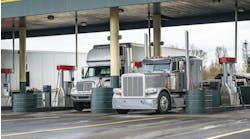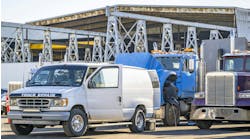The relationship between emissions reduction, technology, and regulations
Emissions reduction, technology, and regulations have gone hand-in-hand for more than two decades. During this time, increased emissions reductions have meant adding technology to existing vehicle architecture, according to Mihai Dorobantu, Eaton Vehicle Group’s director of technology planning and government affairs, who spoke at a recent NationaLease meeting.
In the first rounds of emissions reduction from 2002 to 2010, according to Dorobantu, the goal was 90% reduction of NOx, which was reached via the engine and aftertreatment systems, including adding exhaust gas recirculation, diesel particular fluids, and selective catalytic reduction (SCR). From 2014 to today, a 20% reduction in CO2 has been achieved because of changes to vehicle technology such as aerodynamics, tires, automation, and engine improvements.
See also: Half of Class 8 regional-haul tractors are electrifiable now, study finds
However, Dorobantu said that the next round of emissions reduction will include multiple types of architectures, fuels, and infrastructures. Fuels will include 48V diesel, hybrids, battery-electric, hydrogen fuel cells, natural gas, and zero-carbon fuels.
Three key regulations are driving the latest emission-reduction efforts:
- Omnibus—Commercial vehicle NOx. This rule features stringent NOx limits and will require more aftertreatment and active thermal management.
- Advanced Clean Trucks—Zero-emission vehicle sales mandates. This rule sets sales targets for Classes 6-8 zero-emission vehicle production between 2024 and 2035.
- Advanced Clean Fleets—Zero-emission purchasing mandates. This rule focuses on drayage operations, stating that all new trucks will be zero emissions and that there will be a rapid retirement of trucks powered by internal combustion engines. By 2035, no internal combustion engines will be allowed in ports in California.
See also: Class 8 natural gas retail sales gain momentum, report finds
Dorobantu added that low NOx is achievable but has concerns about the durability and cost to reach the goals. Things like cylinder deactivation, active heating, and close-coupled SCR will help meet the objectives to lower NOx levels.
When it comes to battery-electric vehicles, there are risks and costs centering on range and charging infrastructure. Dorobantu noted that technology solutions exist that allow the trucking industry to meet emissions reduction goals, but the industry “is a little late” in deploying them and “the path to affordability is still very unclear.”
Eaton anticipates a combination of low NOx diesel, electric vehicles, and maybe hybrids to reach the goals, Dorobantu said. However, whether there will be a pre-buy prior to regulatory implementation deadlines will depend on credits, costs, and infrastructure deployment.
Jane Clark focuses on managing the member services operation at NationaLease as vice president of member services. She works to strengthen member relationships, reduce member costs, and improve collaboration within the NationaLease supporting groups.



